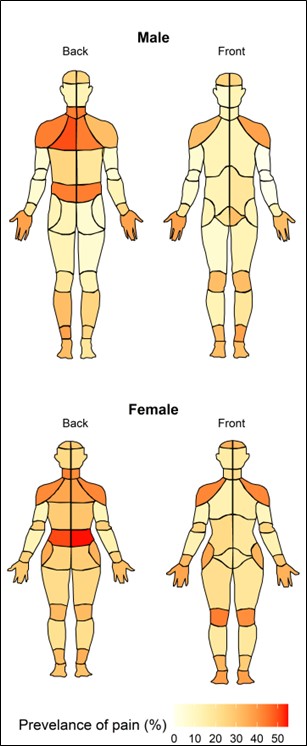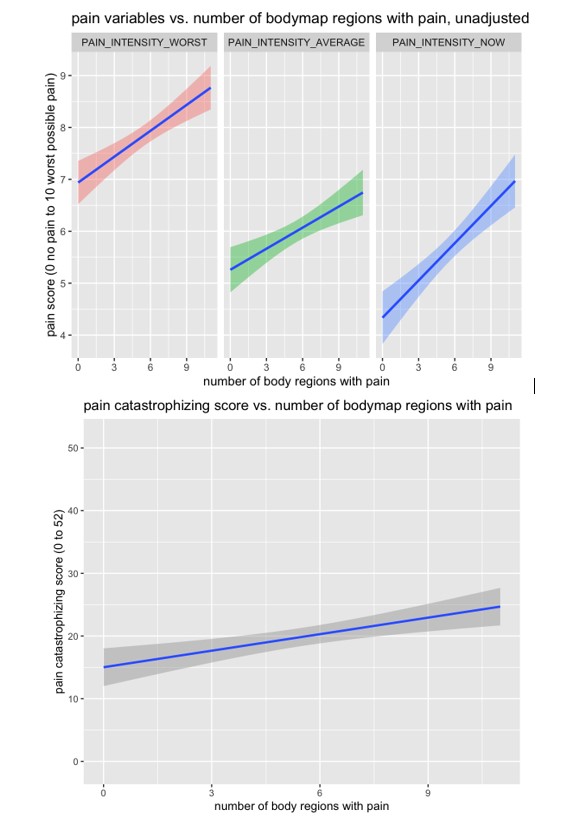Session Information
Session Type: Poster Session B
Session Time: 10:30AM-12:30PM
Background/Purpose: Systemic lupus erythematosus (SLE), characterized by an autoimmune attack of healthy tissues, presents a complex collection of symptoms affecting multiple organ systems. Among these, chronic pain stands out as a challenge, significantly impacting the daily lives and well-being of many patients. The presence of numerous painful sites is associated with worse health outcomes such as increased sleep disturbance and worsened quality of life across a variety of disease states. Examining associations between biopsychosocial factors and pain distribution may help identify factors that are correlated with widespread pain or the presence of numerous painful sites and inform targeted interventions for patients with SLE with chronic pain. Despite their potential usefulness, pain body maps have not been commonly used in rheumatology, specifically in SLE. We aimed to characterize how diverse pain body map regions correlate with the Patient-Reported Outcomes Measurement Information System (PROMIS) measures. This provides a multidimensional perspective on the impact of pain on biopsychosocial factors in patients with SLE and will lay the groundwork for targeted interventions and a deeper understanding of the lived experiences of individuals at the complex intersection of SLE and chronic pain
Methods: We leveraged the Collaborative Health Outcomes Information Registry (CHOIR) pain body map, which is a unique tool that allows patients to articulate their pain experiences in granular detail, fostering a comprehensive examination of the spatial dimensions of pain. We retrospectively analyzed the electronic health records (EHR) of 332 adult patients with SLE attending pain clinics at an academic medical center. The study included demographics, pain distribution assessed via self-reported body maps, and PROMIS assessments of biopsychosocial experiences. We used linear regression models adjusted for age and sex to investigate associations between pain distribution and PROMIS outcomes.
Results: Men, on average, indicated pain in 3.2 regions, while women reported pain in 5.6 regions. Women predominantly highlighted the hip, buttock, and leg region, while men mostly emphasized the shoulder and arm region (Figure 1). We found a positive correlation between pain widespreadness and worse PROMIS measures, including pain interference, behavior, fatigue, depression, anxiety, sleep disturbance, and social isolation (Figures 2 & 3). Additionally, widespread pain was associated with lower physical function, emotional support, and satisfaction in roles and activities (Figures 2 & 3). Female patients reported higher levels of pain and PROMIS measures compared to males.
Conclusion: Our findings highlight the multidimensional impact of pain on SLE patients’ lives underscoring the need for holistic pain management approaches. The intricate associations between pain distribution and biopsychosocial factors emphasize the importance of considering spatial dimensions of pain in clinical interventions. Further research is warranted to explore effective interventions addressing psychosocial aspects of pain in SLE, aiming to enhance patient symptom management and quality of life.
To cite this abstract in AMA style:
Jiang T, Mackey S, Darnall B, Simard J, Falasinnu T. The Problem of Pain in Systemic Lupus Erythematosus: A Comprehensive Analysis of Pain Distribution Using the CHOIR Body Map and PROMIS Measures [abstract]. Arthritis Rheumatol. 2024; 76 (suppl 9). https://acrabstracts.org/abstract/the-problem-of-pain-in-systemic-lupus-erythematosus-a-comprehensive-analysis-of-pain-distribution-using-the-choir-body-map-and-promis-measures/. Accessed .« Back to ACR Convergence 2024
ACR Meeting Abstracts - https://acrabstracts.org/abstract/the-problem-of-pain-in-systemic-lupus-erythematosus-a-comprehensive-analysis-of-pain-distribution-using-the-choir-body-map-and-promis-measures/



